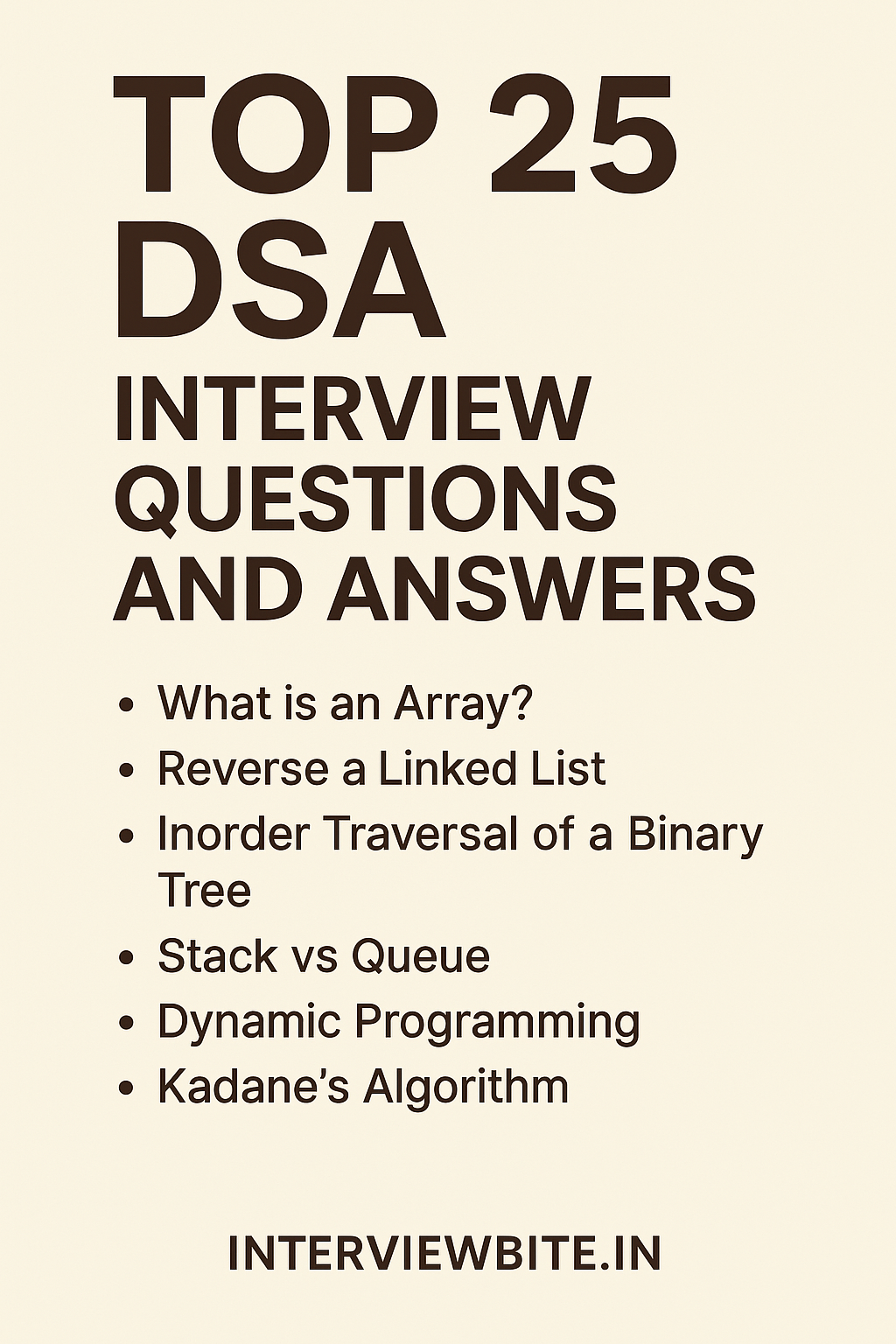Preparing for a technical interview? Data Structures and Algorithms (DSA) form the core of most coding interviews, especially for roles at FAANG and top product-based companies. In this post, we’ve compiled the most commonly asked DSA questions along with short, clear answers and Python examples.
🧩 1. What is an Array?
An array is a linear data structure that stores elements in contiguous memory locations.
✅ Common Interview Use: Searching, sorting, sliding window problems.
🔁 2. How to Reverse an Array in Python?
pythonCopyEditarr = [1, 2, 3, 4, 5]
reversed_arr = arr[::-1]
print(reversed_arr)
📚 3. What is a Linked List?
A linked list is a linear data structure where each element is a node pointing to the next one.
✅ Used in: Dynamic memory allocation, stacks, and queues.
🧵 4. Reverse a Linked List
pythonCopyEditdef reverse_list(head):
prev = None
while head:
next = head.next
head.next = prev
prev = head
head = next
return prev
🌲 5. What is a Binary Tree?
A binary tree is a hierarchical structure where each node has at most two children: left and right.
🔍 6. Inorder Traversal of a Binary Tree
pythonCopyEditdef inorder(root):
if root:
inorder(root.left)
print(root.val)
inorder(root.right)
🎯 7. What is Binary Search?
A divide-and-conquer algorithm for sorted arrays.
pythonCopyEditdef binary_search(arr, target):
low, high = 0, len(arr)-1
while low <= high:
mid = (low + high)//2
if arr[mid] == target:
return mid
elif arr[mid] < target:
low = mid + 1
else:
high = mid - 1
return -1
💡 8. What is the Time Complexity of Binary Search?
- O(log n)
🧠 9. Stack vs Queue
- Stack: LIFO (Last In, First Out)
- Queue: FIFO (First In, First Out)
🔄 10. Implement Stack Using List
pythonCopyEditstack = []
stack.append(1)
stack.pop()
📥 11. What is Recursion?
A function calling itself. Used in tree traversal, backtracking, etc.
🧪 12. Fibonacci Using Recursion
pythonCopyEditdef fib(n):
if n <= 1:
return n
return fib(n-1) + fib(n-2)
🧱 13. What is Dynamic Programming?
An optimization technique that solves complex problems by breaking them into overlapping sub-problems.
🪄 14. Memoized Fibonacci
pythonCopyEditdp = {}
def fib(n):
if n in dp:
return dp[n]
if n <= 1:
return n
dp[n] = fib(n-1) + fib(n-2)
return dp[n]
🧮 15. What is a HashMap / Dictionary?
Key-value data structure with O(1) average time for insertion/search.
⚔️ 16. Two Sum Problem (Using Hashmap)
pythonCopyEditdef two_sum(nums, target):
seen = {}
for i, num in enumerate(nums):
diff = target - num
if diff in seen:
return [seen[diff], i]
seen[num] = i
🔄 17. Difference Between BFS and DFS
- BFS: Level-order traversal using a queue
- DFS: Depth-wise using recursion or stack
🧪 18. Detect Cycle in a Graph
Use DFS with visited + recursion stack or Union-Find.
🏁 19. Topological Sort
Used in dependency resolution (e.g., course scheduling).
🧬 20. What is a Trie?
A tree-like data structure used to store words efficiently.
🧩 21. Sliding Window Technique
Used for subarray problems – keeps track of a subset of data.
📈 22. Kadane’s Algorithm (Max Subarray Sum)
pythonCopyEditdef max_subarray(arr):
max_sum = current = arr[0]
for num in arr[1:]:
current = max(num, current + num)
max_sum = max(max_sum, current)
return max_sum
🧠 23. What is a Heap?
A special tree-based structure used in priority queues.
🔁 24. What is Backtracking?
Used to explore all possibilities — like solving Sudoku.
🧪 25. What is Big O Notation?
Describes time/space complexity:
- O(1): Constant
- O(n): Linear
- O(log n): Logarithmic
✅ Conclusion:
These DSA interview questions cover a mix of theory and practical coding problems. Practice them in Python and try solving variations on platforms like:
- LeetCode
- HackerRank
- InterviewBit
Want more deep-dives into specific topics like trees, graphs, or DP? Let us know in the comments or check out our DSA Series ➜
